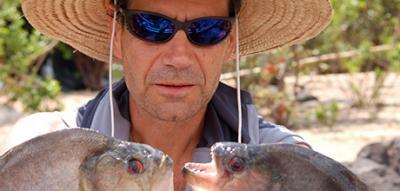Taking body size into account, the black piranha and the extinct megapiranha have the most powerful bites of carnivorous fishes throughout known history.
It's no surprise they were both in the finals: The piranhas' specialized jaw morphology allows them to attack and bite chunks out of much larger prey and their aggressive nature, relatively small size and accessible populations make them a suitable group of predatory vertebrates in which to study the evolution of extreme biting capabilities. Even at their small body sizes, diet studies indicate that piranhas will attack and bite chunks of bony fins and flesh from prey many times larger than themselves.
In spite of their reputation, no quantitative data or empirical estimates regarding the piranhas biting abilities were available.
A new paper reports the first bite-force measurements taken from wild specimens of the largest species of carnivorous piranha in the Amazon, the black piranha, and describes the underlying functional morphology of the jaws that allows this creature to bite with a force more than 30 times greater than its weight. The powerful bite is achieved primarily due to the large muscle mass of the black piranha's jaw and the efficient transmission of its large contractile forces through a highly modified jaw-closing lever.

This shows Guillermo Ortí, the George Washington University Louis Weintraub Professor of Biology, posing with piranhas during a trip to the Amazon. He co-authored a paper with other researchers studying the bite force of piranhas and found that the fish has the most powerful bites of carnivorous fishes, living or extinct, once body size is taken into account. Credit: Guillermo Orti
The expedition
to the Xingu and Iriri rivers in Amazonia to collect the data on the fish
was organized and filmed by National Geographic and a subsequent program called Megapiranha aired on the National Geographic Channel that featured the expedition and focused on the creature that existed millions of years ago.
"It was very exciting to participate in this project, travel one more time to the Amazon to be able to directly measure bite forces in the wild," said Guillermo Ortí, Professor of Biology
at George Washington University
and co-author of the paper. "I learned a lot of biomechanics from my colleagues while collecting valuable specimens for my own research."
The authors also reconstructed the bite force of the megapiranha, showing that for its relatively diminutive body size, the bite of this fossil piranha dwarfed that of other extinct mega-predators, including the whale-eating shark and the Devonian placoderm. Research at the Ortí lab at GW continues to focus on reconstructing the genealogical tree of fishes including piranhas based on genomic data.
Published in Scientific Reports.




Comments